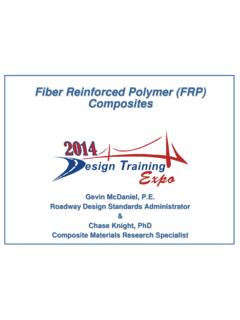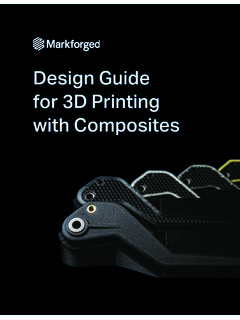Transcription of Optimized Carbon Fiber Composites in Wind Turbine Blade …
1 SANDIA REPORT SAND2019-14173 Printed November 2019 Optimized Carbon Fiber Composites in Wind Turbine Blade Design Brandon L. Ennis, Christopher L. Kelley, Brian T. Naughton Sandia National Laboratories Robert E. Norris, Sujit Das, Dominic Lee Oak Ridge National Laboratory David A. Miller Montana State University Prepared by Sandia National Laboratories Albuquerque, New Mexico 87185 and Livermore, California 94550 2 Issued by Sandia National Laboratories, operated for the United States Department of Energy by National Technology & Engineering Solutions of Sandia, LLC. NOTICE: This report was prepared as an account of work sponsored by an agency of the United States Government. Neither the United States Government, nor any agency thereof, nor any of their employees, nor any of their contractors, subcontractors, or their employees, make any warranty, express or implied, or assume any legal liability or responsibility for the accuracy, completeness, or usefulness of any information, apparatus, product, or process disclosed, or represent that its use would not infringe privately owned rights.
2 Reference herein to any specific commercial product, process, or service by trade name, trademark, manufacturer, or otherwise, does not necessarily constitute or imply its endorsement, recommendation, or favoring by the United States Government, any agency thereof, or any of their contractors or subcontractors. The views and opinions expressed herein do not necessarily state or reflect those of the United States Government, any agency thereof, or any of their contractors. Printed in the United States of America. This report has been reproduced directly from the best available copy. Available to DOE and DOE contractors from Department of Energy Office of Scientific and Technical Information Box 62 Oak Ridge, TN 37831 Telephone: (865) 576-8401 Facsimile: (865) 576-5728 E-Mail: Online ordering: Available to the public from Department of Commerce National Technical Information Service 5301 Shawnee Rd Alexandria, VA 22312 Telephone: (800) 553-6847 Facsimile: (703) 605-6900 E-Mail: Online order: 3 ABSTRACT The objective of this study is to assess the commercial viability to develop cost-competitive Carbon Fiber Composites specifically suited for the unique loading experienced by wind Turbine blades.
3 The wind industry is a cost-driven market, while Carbon Fiber materials have been developed for the performance-driven aerospace industry. Carbon Fiber has known benefits for reducing wind Turbine Blade mass due to the significantly improved stiffness, strength, and fatigue resistance per unit mass compared to fiberglass; however, the high relative cost has prohibited broad adoption within the wind industry. Novel Carbon Fiber materials derived from the textile industry are studied as a potentially more optimal material for the wind industry and are characterized using a validated material cost model and through mechanical testing. The novel heavy tow textile Carbon Fiber is compared with commercial Carbon Fiber and fiberglass materials in representative land- based and offshore reference wind Turbine models.
4 Some of the advantages of Carbon Fiber spar caps are observed in reduced Blade mass and improved fatigue life. The heavy tow textile Carbon Fiber is found to have improved cost performance over the baseline Carbon Fiber and performed similarly to the commercial Carbon Fiber in wind Turbine Blade design, but at a significantly reduced cost. This novel Carbon Fiber was observed to even outperform fiberglass when comparing material cost estimates for spar caps Optimized to satisfy the design constraints. This study reveals a route to enable broader Carbon Fiber usage by the wind industry to enable larger rotors that capture more energy at a lower cost. 4 ACKNOWLEDGEMENTS This work has been funded by the Department of Energy (DOE) Wind Energy Technologies Office.
5 The authors would like to thank Lillie Ghobrial and Mike Derby from DOE for their support throughout this project. The authors also recognize the contributions by members of the Industry Advisory Panel which supported this project. The combined experience of these distinguished staff from Turbine OEMs, Carbon Fiber manufacturers, Blade manufacturers, and wind Turbine design consultants has been very beneficial to guiding project decisions and providing critical feedback. The developmental textile Carbon Fiber materials studied within this project were supplied by the Carbon Fiber Technology Facility, an Oak Ridge National Laboratory User Facility which is sponsored by the Advanced Manufacturing and Vehicle Technologies Offices within the Department of Energy.
6 Oak Ridge National Laboratory is operated by UT-Battelle, LLC. under Contract No. DEAC05-00OR22725 with the Department of Energy. 5 CONTENTS 1. Introduction .. 12 Background and Motivation .. 12 Purpose of Study .. 16 2. Carbon Fiber Study Material Definition .. 18 Material Description .. 19 Zoltek PX-35 (industry baseline) .. 20 ORNL CFTF Kaltex .. 21 ORNL CFTF Taekwang .. 23 Tow Cross-Section Area Comparisons .. 23 Mechanical Testing Results .. 24 composite Form Manufacturing Description .. 25 Aligned Strand Infusion .. 25 Commercial Pultrusion .. 26 Third-Party Pultrusion .. 26 Tested Results .. 28 Carbon Fiber Cost Modeling .. 30 Industry Baseline Carbon Fiber Cost .. 32 Heavy-Tow Textile Carbon Fiber Cost .. 33 Material Property Cost Relationships.
7 36 Pultrusion Manufacturing Cost .. 37 Model Material Inputs .. 39 Model Input Design Strength Calculation .. 43 3. Wind Turbine Blade Definition .. 47 Land- based Turbine in a Low Wind Resource .. 47 Offshore Turbine in a High Wind Resource .. 48 4. Wind Turbine Blade Spar Cap Optimization Studies .. 50 Optimization Configuration Description .. 50 Optimization Results for Land- based Turbine in a Low Wind Resource .. 51 Optimization Results for Offshore Turbine in a High Wind Resource .. 55 5. Summary and Limitations of Findings .. 58 6. Conclusion .. 62 Appendix A. Carbon Fiber Cost Modeling Details .. 64 Appendix B. Reference Blade Materials .. 68 6 LIST OF FIGURES Figure 1-1. Global trends for wind Turbine power rating and diameter increase.
8 13 Figure 1-2. Global market share of installed wind turbines with spar caps using glass Fiber reinforced polymers (GFRP) versus Carbon Fiber reinforced polymers (CFRP).. 14 Figure 1-3. Percentage of Turbine platforms with Carbon Fiber spar caps versus Blade length.. 14 Figure 1-4. Percentage of installed turbines with Carbon Fiber spar caps versus power rating.. 15 Figure 1-5. Breakdown of Turbine models with Carbon Fiber spar caps for the top 15 OEMs.. 16 Figure 1-6. Wind Turbine Blade sectional drawing with region identification.. 17 Figure 2-1. Example pultrusion manufacturing process.. 19 Figure 2-2. Published technical data for Zoltek PX35 Carbon Fiber [2].. 21 Figure 2-3. Example tow test results for CFTF Carbon Fiber using Kaltex precursor.. 22 Figure 2-4.
9 Example tow test results for CFTF Carbon Fiber using Kaltex precursor used in pultrusion manufacturing.. 22 Figure 2-5. Example tow test results for CFTF Carbon Fiber using Taekwang precursor.. 23 Figure 2-6. Example of initial heavy-tow CFTF material winding.. 24 Figure 2-7. Sample aligned strand infusion processing [1].. 26 Figure 2-8. CFTF tows mounted to spindles and traversing guides for pultrusion.. 27 Figure 2-9. CFTF material being dipped through resin and pulled through the pultrusion die.. 27 Figure 2-10. Fatigue test comparison of the study materials, R= (Zoltek in commercial pultrusion (VF=62%), CFTF materials in aligned strand infusion (VF~50%)).. 30 Figure 2-11. Sequential major processing steps of Carbon Fiber manufacturing.. 31 Figure 2-12.
10 Total baseline 50k tow Carbon Fiber cost distribution by four major cost categories.. 33 Figure 2-13. Baseline 50k tow Carbon Fiber cost ($/kg) distribution by major processing steps.. 33 Figure 2-14. Carbon Fiber cost sensitivity to its mechanical properties.. 37 Figure 2-15. Carbon Fiber -reinforced spar cap cost breakdown of three different Carbon Fiber cost scenarios.. 39 Figure 2-16. High-cycle fatigue exponent calculation from R= fatigue tests.. 45 Figure 3-1. Top view and chord and thickness profiles for the SNL 3MW reference Blade .. 48 Figure 3-2. Top view and chord and thickness profiles for the IEA 10 MW reference Blade .. 49 Figure 4-1. Land- based Turbine optimal solution constraint values.. 53 Figure 4-2. Land- based Turbine optimal solution spar cap dimensions.













